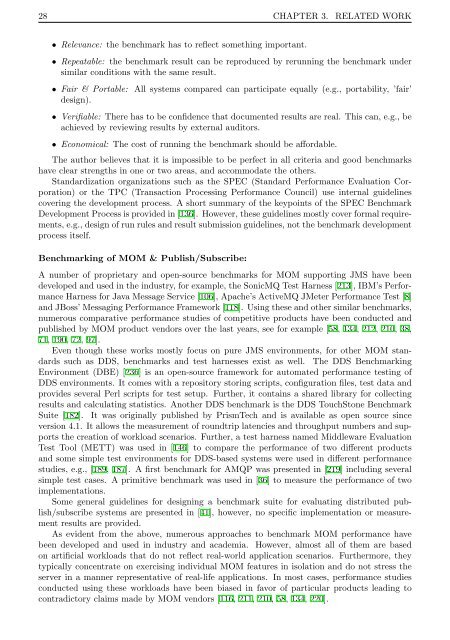Performance Modeling and Benchmarking of Event-Based ... - DVS
Performance Modeling and Benchmarking of Event-Based ... - DVS
Performance Modeling and Benchmarking of Event-Based ... - DVS
Create successful ePaper yourself
Turn your PDF publications into a flip-book with our unique Google optimized e-Paper software.
28 CHAPTER 3. RELATED WORK<br />
• Relevance: the benchmark has to reflect something important.<br />
• Repeatable: the benchmark result can be reproduced by rerunning the benchmark under<br />
similar conditions with the same result.<br />
• Fair & Portable: All systems compared can participate equally (e.g., portability, ’fair’<br />
design).<br />
• Verifiable: There has to be confidence that documented results are real. This can, e.g., be<br />
achieved by reviewing results by external auditors.<br />
• Economical: The cost <strong>of</strong> running the benchmark should be affordable.<br />
The author believes that it is impossible to be perfect in all criteria <strong>and</strong> good benchmarks<br />
have clear strengths in one or two areas, <strong>and</strong> accommodate the others.<br />
St<strong>and</strong>ardization organizations such as the SPEC (St<strong>and</strong>ard <strong>Performance</strong> Evaluation Corporation)<br />
or the TPC (Transaction Processing <strong>Performance</strong> Council) use internal guidelines<br />
covering the development process. A short summary <strong>of</strong> the keypoints <strong>of</strong> the SPEC Benchmark<br />
Development Process is provided in [136]. However, these guidelines mostly cover formal requirements,<br />
e.g., design <strong>of</strong> run rules <strong>and</strong> result submission guidelines, not the benchmark development<br />
process itself.<br />
<strong>Benchmarking</strong> <strong>of</strong> MOM & Publish/Subscribe:<br />
A number <strong>of</strong> proprietary <strong>and</strong> open-source benchmarks for MOM supporting JMS have been<br />
developed <strong>and</strong> used in the industry, for example, the SonicMQ Test Harness [213], IBM’s <strong>Performance</strong><br />
Harness for Java Message Service [106], Apache’s ActiveMQ JMeter <strong>Performance</strong> Test [8]<br />
<strong>and</strong> JBoss’ Messaging <strong>Performance</strong> Framework [118]. Using these <strong>and</strong> other similar benchmarks,<br />
numerous comparative performance studies <strong>of</strong> competitive products have been conducted <strong>and</strong><br />
published by MOM product vendors over the last years, see for example [58, 134, 212, 210, 38,<br />
71, 190, 72, 97].<br />
Even though these works mostly focus on pure JMS environments, for other MOM st<strong>and</strong>ards<br />
such as DDS, benchmarks <strong>and</strong> test harnesses exist as well. The DDS <strong>Benchmarking</strong><br />
Environment (DBE) [236] is an open-source framework for automated performance testing <strong>of</strong><br />
DDS environments. It comes with a repository storing scripts, configuration files, test data <strong>and</strong><br />
provides several Perl scripts for test setup. Further, it contains a shared library for collecting<br />
results <strong>and</strong> calculating statistics. Another DDS benchmark is the DDS TouchStone Benchmark<br />
Suite [182]. It was originally published by PrismTech <strong>and</strong> is available as open source since<br />
version 4.1. It allows the measurement <strong>of</strong> roundtrip latencies <strong>and</strong> throughput numbers <strong>and</strong> supports<br />
the creation <strong>of</strong> workload scenarios. Further, a test harness named Middleware Evaluation<br />
Test Tool (METT) was used in [146] to compare the performance <strong>of</strong> two different products<br />
<strong>and</strong> some simple test environments for DDS-based systems were used in different performance<br />
studies, e.g., [189, 187]. A first benchmark for AMQP was presented in [219] including several<br />
simple test cases. A primitive benchmark was used in [36] to measure the performance <strong>of</strong> two<br />
implementations.<br />
Some general guidelines for designing a benchmark suite for evaluating distributed publish/subscribe<br />
systems are presented in [41], however, no specific implementation or measurement<br />
results are provided.<br />
As evident from the above, numerous approaches to benchmark MOM performance have<br />
been developed <strong>and</strong> used in industry <strong>and</strong> academia. However, almost all <strong>of</strong> them are based<br />
on artificial workloads that do not reflect real-world application scenarios. Furthermore, they<br />
typically concentrate on exercising individual MOM features in isolation <strong>and</strong> do not stress the<br />
server in a manner representative <strong>of</strong> real-life applications. In most cases, performance studies<br />
conducted using these workloads have been biased in favor <strong>of</strong> particular products leading to<br />
contradictory claims made by MOM vendors [116, 211, 210, 58, 134, 220].















